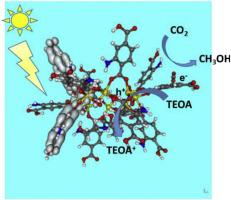Journal of CO2 Utilization ( IF 7.2 ) Pub Date : 2020-09-16 , DOI: 10.1016/j.jcou.2020.101300 Joshua O. Olowoyo , Upasana Saini , Manoj Kumar , Héctor Valdés , Hitendra Singh , Martins O. Omorogie , Jonathan O. Babalola , Alexander V. Vorontsov , Umesh Kumar , Panagiotis G. Smirniotis

|
The development of visible-light active photocatalysts is highly desirable for CO2 reduction to hydrocarbons and alcohols using sunlight. Here, we report the metal-organic frameworks (MOF) of amino-benzene dicarboxylate with titanium oxocluster center (NH2-MIL-125(Ti)) and modified with reduced graphene oxide (RGO), RGO-NH2-MIL-125(Ti), ideal for the visible-light-driven photocatalytic reduction of CO2 to hydrocarbons and methanol. The catalyst provides high quantum efficiency and selectivity for methanol. The cluster model and self-consistent charge density functional tight binding methods were used to investigate the photogenerated charge separation for NH2-MIL-125(Ti). The quantum modelling suggests that holes were accumulated in the central ring Ti8O8(OH)4, where strongly adsorbed electron donor, triethanolamine, undergoes photooxidation while electrons were located in the organic ligand of MOF including the NH2 group. The binding affinity of NH2 reaction sites to CO2 possibly work to improve the photocatalytic reduction of CO2 to methanol. The RGO also play an important role for charge separation and better photocatalytic reduction with RGO-NH2-MIL-125(Ti).
中文翻译:

还原的氧化石墨烯/ NH 2 -MIL-125(Ti)复合材料:在可见光下选择性将CO 2光还原为甲醇,以及对电荷分离的计算见解
对于使用阳光将CO 2还原为碳氢化合物和醇类,非常需要开发可见光活性光催化剂。在这里,我们报告了氨基苯二甲酸钛氧簇中心(NH 2 -MIL-125(Ti))并用还原氧化石墨烯(RGO),RGO-NH 2 -MIL-125改性的金属有机骨架(MOF)(Ti),非常适合在可见光驱动下将CO 2光催化还原为烃和甲醇。该催化剂对甲醇具有高量子效率和选择性。利用簇模型和自洽电荷密度泛函紧密结合方法研究了NH 2的光生电荷分离-MIL-125(Ti)。量子模型表明,空穴聚集在中心环Ti 8 O 8(OH)4中,在那里强吸附的电子给体三乙醇胺发生光氧化,而电子位于包含NH 2基团的MOF有机配体中。NH 2反应位点与CO 2的结合亲和力可能有助于改善CO 2对甲醇的光催化还原。RGO对于RGO-NH 2 -MIL-125(Ti)的电荷分离和更好的光催化还原也起着重要的作用。











































 京公网安备 11010802027423号
京公网安备 11010802027423号